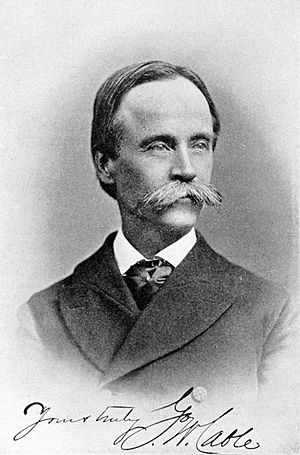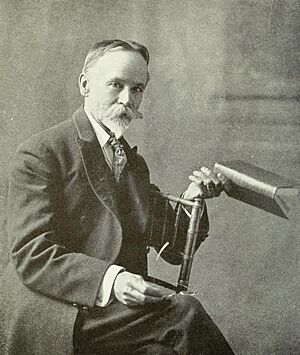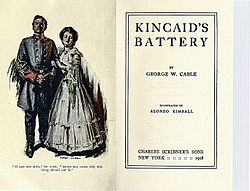George Washington Cable facts for kids
Quick facts for kids
George Washington Cable
|
|
|---|---|

George Washington Cable in 1903
|
|
| Born | October 12, 1844 New Orleans, Louisiana, U.S.
|
| Died | January 31, 1925 (aged 81) St. Petersburg, Florida, U.S.
|
| Occupation | Novelist |
George Washington Cable (born October 12, 1844 – died January 31, 1925) was an American novelist. He was known for writing realistic stories about Creole life in his hometown of New Orleans, Louisiana.
Many people call him "the most important southern artist" of the late 1800s. He is also seen as "the first modern Southern writer." His books talked about important topics like racism and families with mixed racial backgrounds.
Cable also wrote articles that criticized society at the time. Because of strong disagreement with his ideas, he moved his family. In 1885, he wrote essays supporting equal rights for all races and opposing Jim Crow laws. These laws enforced racial segregation. After facing hostility, Cable moved to Northampton, Massachusetts. He lived there for 30 years before moving to Florida.
Early Life in New Orleans
George Washington Cable was born in 1844 in New Orleans, Louisiana. His parents were George W. Cable Sr. and Rebecca Boardman Cable. His family was wealthy and owned enslaved people. They were part of the Presbyterian Church and New Orleans society.
Cable first went to private schools. But his father died young, and the family lost money. So, young Cable had to start working to help his family. He later taught himself to speak French. During the American Civil War, he supported the Southern states. He served in the Confederate States Army.
Cable's Writing Career
Cable's experiences during and after the war changed his views on society. He started writing while recovering from malaria for two years. In 1870, he became a journalist. He wrote for the New Orleans Picayune newspaper. He worked there from 1865 to 1879. By then, he was already a well-known writer. In 1869, George Cable married Louisa Stewart Bartlett. They had several children together.
A magazine called Scribner's Monthly asked him to send stories. They published his story "Sieur George" in 1873. It was very popular and well-received. He published six more stories about Creole life with Scribner's over the next three years. These stories were put together in a book called Old Creole Days in 1879.
His stories showed the many cultures and races in New Orleans before the Civil War. They included people of French, Spanish, African, Native American, and Caribbean backgrounds. He also wrote about conflicts after the Louisiana Purchase. This was when traditional New Orleans Creoles of color met Anglo-Americans. The Anglo-Americans wanted a society with only two races, not many.
In 1880, Cable published his first novel, The Grandissimes: A Story of Creole Life. This book showed different classes and mixed-race people in the early 1800s. It was published shortly after the Louisiana Purchase. The story was first printed in parts in Scribner's magazine.
The novel follows the adventures of members of the Grandissime family. This was a French Creole family with mixed-race members. Cable used this historical story to explore society and its unfairness. He wrote about European Creoles, mixed-race people, and slavery.
In the same year, the United States Census Bureau asked Cable to write about New Orleans before the Civil War. He wrote a very detailed 313-page history. However, only a small part of it was published in 1884. The full book was not published until 2008.
His short novel Madame Delphine (1881) was about a woman of African descent. She tried to arrange a marriage for her daughter, who looked more European. She wanted her daughter to marry into a French Creole elite family. In 1884, he published Dr. Sevier, which was about prison reform.
After these books, Cable focused on two types of writing. He wrote romantic novels and non-fiction articles. In his articles, he showed support for racial equality. He also spoke out against Jim Crow laws. Two of his famous essays were "The Freedman's Case in Equity" and "The Silent South," both from 1885. Many white Southerners did not like his essays.
After the Civil War, white groups worked to regain power. They wanted to control formerly enslaved people and free people of color. Groups like the Ku Klux Klan used threats to stop Black people from voting. After the Reconstruction period, Democrats took control of state governments. They passed laws to stop Black people from voting. They also created legal racial segregation and other strict rules.
Because of the strong opposition, Cable decided to leave the South in 1885. He moved his family to Northampton, Massachusetts. There, he continued to write novels and essays about the South. In 1888, he published Bonaventure. He published 14 novels and collections of short stories in total. His last novel was Lovers of Louisiana (1918).
Cable became a member of the American Antiquarian Society in 1888.
Cable's first wife, Louise, died in 1904. In 1906, he married Eva Stenson. After Eva died, he married a third time to Hanna Cowing in 1923. Two years later, Cable died in St. Petersburg, Florida. He is buried in Bridge Street Cemetery in Northampton, Massachusetts.
Works by George Washington Cable
- Old Creole Days (1879)
- The Grandissimes: A Story of Creole Life (1880)
- Madame Delphine (1881)
- Dr. Sevier (1882)
- The Creoles of Louisiana (1884)
- Bonaventure (1888)
- The Silent South (1889)
- The Negro Question (1890)
- Strange True Stories of Louisiana (1890)
- The Busy Man's Bible and How to Study and Teach It (1891)
- A Memory of Roswell Smith (1892)
- Famous Adventures and Prison Escapes of the Civil War (1893)
- John March, Southerner (1894)
- Strong Hearts (1899)
- The Cavalier (1901)
- Bylow Hill (1902)
- Kincaid's Battery (1908)
- Possen Jone' and Pere Raphael (1909)
- The Amateur Garden (1914)
- Gideon's Band (1914)
- The Flower of the Chapdelaines (1917)
- Lovers of Louisiana (1918)
See also
 In Spanish: George Washington Cable para niños
In Spanish: George Washington Cable para niños



